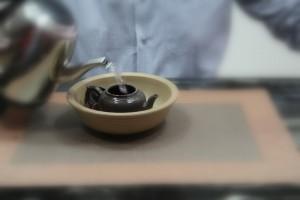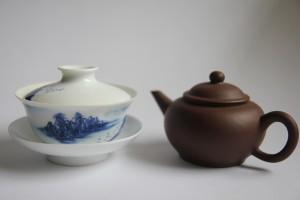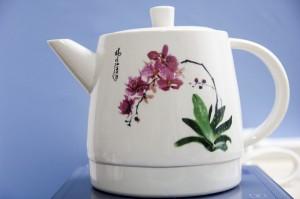One of the numerous unique characteristics of tea is that how it tastes and feels in our mouth is more than just the quality of the tea leaf itself. Unlike wines for example, one does not pour the liquid into the cup and it tastes exactly the way it was meant to be.
The taste of tea is dependent on a number of factors and how they mesh together. Many tea drinkers often focus on a few factors, sometimes even obsessively but ignore the rest. We will also look at how it all meshes together.
Tea Leaves
This is what comes under greatest scrutiny- the quality of the tea leaves and one’s personal preference. The latter is subjective but the former is not.
You can read more about the objective assessment of the quality of tea here and here as well as a buying guide on how to discern the quality of tea.
In the end though, it’s a matter of personal preference. There are some high quality teas that I am not particularly enamored with- certain Taiwanese High Mountain Teas come to mind- while some there are some mid-grade teas such as Huang Jin Gui that I love and are a regular feature in my tea diet.
While this is an important consideration, it doesn’t stop here.
Technique
Probably the next most scrutinized aspect of preparing tea- the technique. Many make the mistake of assuming it’s just a matter of adherence to the guidelines or ‘parameters’ as I like to call it, namely:

ii) Infusion time
iii) Temperature of hot water used
iv) Number of infusions
While this is important, it is not the alpha and the omega. And I certainly don’t think it’s the case that a laboratory-like approach to brewing tea results in the best tasting tea. I don’t whip out my weighing scale and timers each time I brew tea, only when I’m experimenting or I only have a one serving sample on hand and I’m making it for the first time.
Brewing technique entails more than that, about the little stuffs- how water is poured and most importantly the ability to read and react to the tea.
Certain teas need a bit more velocity in pouring water to ‘awaken’ its tea nature while others will result in a ‘throat-locking’ feel if you do that.
Tea Wares

While we do advocate pairing the right utensils with the type of tea as well the quality of the vessel, I caution against rushing to acquire the finest Yixing pots or gaiwan on the market.
Firstly, tea wares can cost a pretty penny. It’s not surprising for someone to spend hundreds of dollars on Yixing pots or tea sets. Considering the ROI, I feel the money can be better spent, at least at the initial stage.
Secondly, the taste of your tea will ultimately only be as good as the weakest link. If you spend top dollar on tea wares, unless you have a limitless budget (in which case would you like to drop by our excellent tea store, I jest but only half), the money you spend there will detract from other spending that gives you more bang for buck.
Water
The old adage holds true, “water is the mother of tea”. The impact of water on the taste of tea cannot be overstated.
More details can be found here but to cut a long story short, unless you stay next to a spring, these are my suggestions in descending order of priority:
i) Volvic- not affiliated with them in anyway, just my personal favorite
ii) Fuji Water
iii) Carbon-filtered water
iv) Tap water left overnight in a clean tasteless container to allow the chlorine smell to dispel
v) Reverse-osmosis
vi) Tap water
No natural sources of water are listed because I live in an urbanized environment and natural water is either unavailable or where it is, I’m fearful of drinking it without desalination and stuff which renders it the same or a step below tap water for this purpose.
Kettle

While Tetsubin or cast-iron kettles are considered the ‘holy grail’ of boiling water for its heat retention and sweeter taste, I don’t have firsthand experience with it at point of writing, largely because running a new startup fulltime doesn’t allow me the financial flexibility to drop more than $200 on one when I have 3 dedicated tea kettles at home.
Nevertheless, this will be a topic I will revisit and share in the (hopefully, near) future.
Accessories
Do you drink your Lafite out of a Styrofoam cup? I didn’t think so.
The drinking cup makes a difference. Porcelain retains the fragrance better and the texture is smoother while Yixing clay retains heat better.
The shape and size of the cup also comes into play and affects the heat retention or aroma of the tea.
If you are drinking oolong tea especially, smaller cups (and vessels) are the way to go.
Putting it all Together
When we are venturing in the world of tea, it is tempting to get the ‘best’ of something. As mentioned, unless you are related to Li Ka-Shing and friends, everyone has a budget. If you spend $150 on 100g of Dahongpao but wind up making tea out of a French Press (or whatever is lying about your kitchen because you don’t have budget for a gaiwan or Yixing pot) with tap water boiled in a rusty kettle on the stove, you are not maximizing your expenditure.
Simply put, your tea will only taste as good as the weakest link. Against my personal commercial instincts, I would recommend new tea drinkers to get a mid-grade tea- usually in the $10-25 per 50g range and experiment from there. Rather than getting a swanky Yixing (Zisha) pot and blowing the bank, get a well-made gaiwan and save the money for Volvic or a carbon filter and/or a decent tea kettle.
The most important thing is to drink more and brew more. That way you can improve your technique and once you reach a plateau you can consider that Yixing, expensive tea or Tetsubin kettle or whichever captures your fancy.
Remember, your tea only tastes as well as the weakest link would allow.
See more articles related to brewing tea
